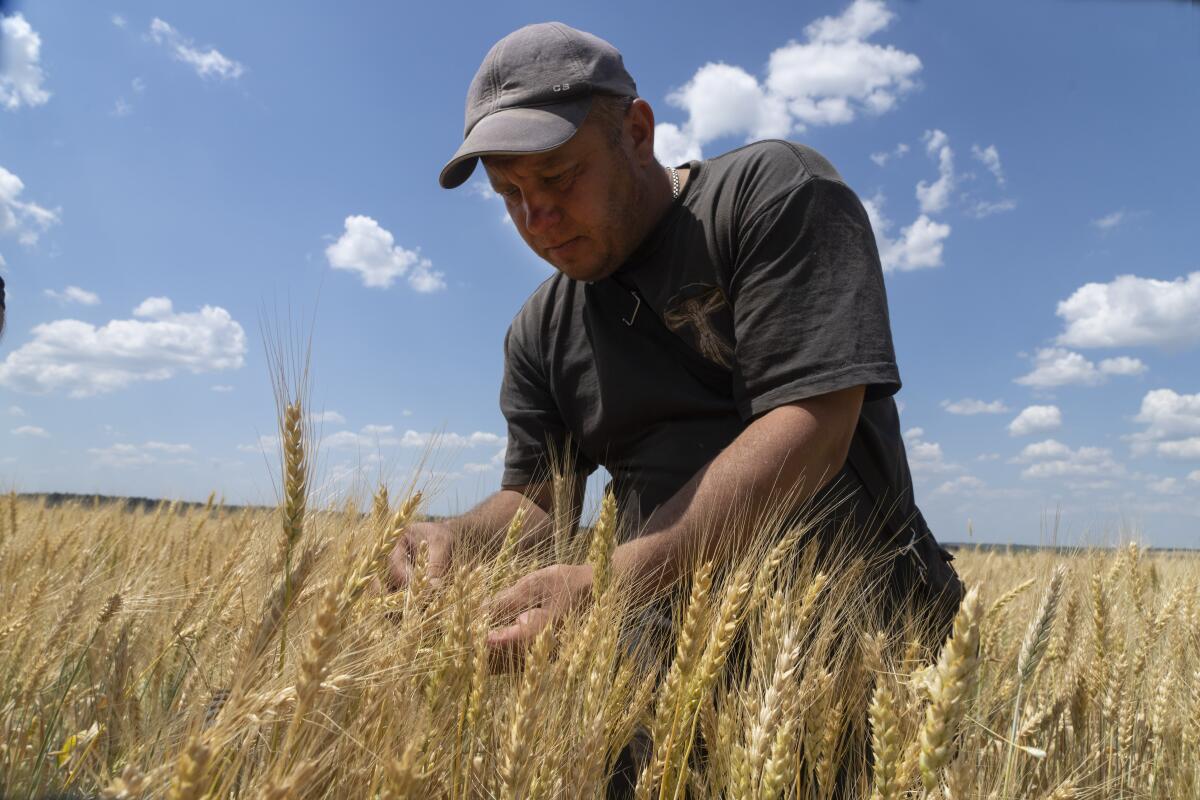Why allowing Ukraine to ship grain during Russia’s war matters to the world

LONDON — Russia has suspended a wartime deal designed to move grain from Ukraine to parts of the world where millions are going hungry.
The Black Sea Grain Initiative, brokered by the United Nations and Turkey, has allowed 36.2 million tons of food to be exported from Ukraine since August, more than half to developing countries, according to the Joint Coordination Center in Istanbul.
Some analysts don’t foresee a lasting rise in the cost of commodities like wheat because there’s enough grain in the world to go around. But many countries are already struggling with high local food prices, which are helping fuel hunger. And Russian attacks this week on Black Sea port cities are driving prices higher.
Here’s a look at the crucial accord and what it means for the world:
What is the grain deal?
Ukraine and Russia signed separate agreements in July 2022, one that reopened three of Ukraine’s Black Sea ports that were blocked for months following Moscow’s invasion. The other facilitated the movement of Russian food and fertilizer amid Western sanctions.
Both countries are major suppliers of wheat, barley, sunflower oil and other affordable food products that Africa, the Middle East and other parts of Asia rely on. Ukraine is also a huge exporter of corn, and Russia of fertilizer — other critical parts of the food chain.
Interrupted shipments from Ukraine, dubbed the “breadbasket of the world,” exacerbated a global food crisis and sent prices for grain soaring worldwide.
A third night of Russian air attacks pounded Ukraine’s southern cities, including the Black Sea port city of Odesa, and killed at least two people.
The deal provided assurances that ships won’t be attacked entering and leaving Ukrainian ports. Vessels were checked by Russian, Ukrainian, U.N. and Turkish officials to ensure they carry only food.
Meant to be extended every four months, the deal was hailed as a beacon of hope and was renewed three times — the last two for only two months as Russia insisted its exports were being held up. That’s despite Moscow shipping record amounts of wheat.
No new ships have joined the initiative since June 27, and Ukraine blames Russia. The last vessel left Ukraine on Sunday.
How do citizens of Kyiv cope with the sleep deprivation and stress from Russia’s war on Ukraine? Some push it down, some try yoga or dancing.
What has it accomplished?
The deal helped bring down global prices of food commodities like wheat that reached record highs after Russia invaded Ukraine.
Once the grain deal was struck, the World Food Program got back a top supplier, allowing 725,000 metric tons of humanitarian food aid to leave Ukraine and reach countries on the precipice of famine, including Ethiopia, Afghanistan and Yemen.
“It is a pretty unique phenomenon to have two warring parties and two intermediaries agree to establish this sort of corridor to get humanitarian products — which is ostensibly what this is — out to markets that need it most,” said John Stawpert, senior manager of environment and trade for the International Chamber of Shipping, which represents 80% of the world’s commercial fleet.
After Russia exited the deal, wheat prices in Chicago trading rose about 3% on Monday, to $6.81 a bushel, still about half what they were during last year’s peaks. Prices fell later in the day.
Even far from Ukraine’s front lines, military funerals set off waves of mourning. ‘You can’t see an end to it,’ one chaplain says as the war drags on.
Why did Russia end the deal?
Russia has said it wants an end to sanctions on the Russian Agricultural Bank and to restrictions on shipping and insurance that Moscow says have hampered its agricultural exports.
Some companies have been wary of doing business with Russia because of sanctions, but Western allies have made assurances that food and fertilizer are exempt.
“It’s not uncommon in situations like this for countries to use whatever levers they have to try and get sanctions regimes changed,” said Simon Evenett, professor of international trade and economic development at the University of St. Gallen in Switzerland.
Russia also has complained that a commitment to send its ammonia, a key component of fertilizer, to a Ukrainian port via pipeline to be exported has never started under the deal. That’s true, but the U.N. says the pipeline has been damaged in the fighting.
“Regrettably, the part of the Black Sea agreements related to Russia hasn’t been fulfilled,” Kremlin spokesman Dmitry Peskov said Monday.
U.N. Secretary-General António Guterres sent a letter to Russian President Vladimir Putin last week proposing to ease transactions through the agricultural bank, a spokesperson said.
The Russian Defense Ministry said in a statement Monday that the last-minute offer was not feasible and couldn’t be implemented.
Russian “claims that its agriculture sector is suffering are countered by the reality” that production and exports are up since before the war, said Caitlin Welsh, director of the Global Food and Water Security Program at the Center for Strategic and International Studies.
Russia exported a record 45.5 million metric tons of wheat in the 2022-23 trade year, with another all-time high of 47.5 million metric tons expected in 2023-24, according to U.S. Department of Agriculture estimates.
Russian President Vladimir Putin’s KGB years in East Germany offer a window into his crackdown on protests, war on Ukraine and yearning for empire.
Who is affected?
The International Rescue Committee calls the grain deal a “lifeline for the 79 countries and 349 million people on the frontlines of food insecurity.”
Losing millions of tons of food from Ukraine at a time when many countries are increasingly reliant on imported food because of conflict and drought “will result in inaccessibility and unavailability of food but also will increase prices and impact affordability for households,” Shashwat Saraf, the group’s regional emergency director for East Africa, said in an interview Monday.
While global prices for grain may stabilize, countries that depend on imported food, from Lebanon to Egypt, may see their costs rise for a while if they need to find suppliers that are farther away, analysts say.
That will compound costs for countries that also have seen their currencies weaken and debt levels grow because they pay for food shipments in dollars.
For low-income countries and people, food “will be less affordable,” World Food Program chief economist Arif Husain told reporters last week.
What about Ukraine?
Ukraine’s economy depends on agriculture, and before the war, 75% of its grain exports went through the Black Sea. It can send its food by land or river through Europe, but those routes can handle lower amounts than sea shipments and their use has stirred anger in neighboring countries.
Nonetheless, the Ukrainian Grain Assn. wants to send more grain through the Danube River to neighboring Romania’s Black Sea ports, saying it’s possible to double monthly exports along that route to 4 million metric tons.
Ukraine’s wheat shipments have fallen by more than 40% from its prewar average, with the U.S. Department of Agriculture expecting 10.5 million metric tons exported in the coming year. Ukraine accused Russia of slowing down inspections of ships. Combined with no new ships joining the effort, that has led to a drop in exports from a high under the deal of 4.2 million metric tons in October to 2 million in June.
This week, Russia has targeted Ukrainian critical grain export infrastructure and has pounded Ukraine’s southern cities with drones and missiles, keeping the Black Sea port city of Odesa in the Kremlin’s crosshairs.
What else affects food supply?
Fallout from the pandemic, conflict, economic crises, drought and other climate factors affect the ability of people to get enough to eat.
There are 45 countries that need food assistance, the Food and Agriculture Organization of the U.N. said in a July report. High domestic food prices are driving hunger in most of those countries, including Haiti, Ukraine, Venezuela and several in Africa and Asia.
While drought can also be a problem for major grain suppliers, analysts see other countries producing enough grain to counterbalance losses from Ukraine.
Besides Russia’s huge exports, Europe and Argentina are increasing wheat shipments, while Brazil saw a banner year for corn.
“These markets adapt and producers adapt — and, boy, the wheat and corn markets have adapted very, very quickly,” said Peter Meyer, head of grain analytics at S&P Global Commodity Insights.
Associated Press writer Edith M. Lederer at the United Nations contributed to this report.
More to Read
Sign up for Essential California
The most important California stories and recommendations in your inbox every morning.
You may occasionally receive promotional content from the Los Angeles Times.














